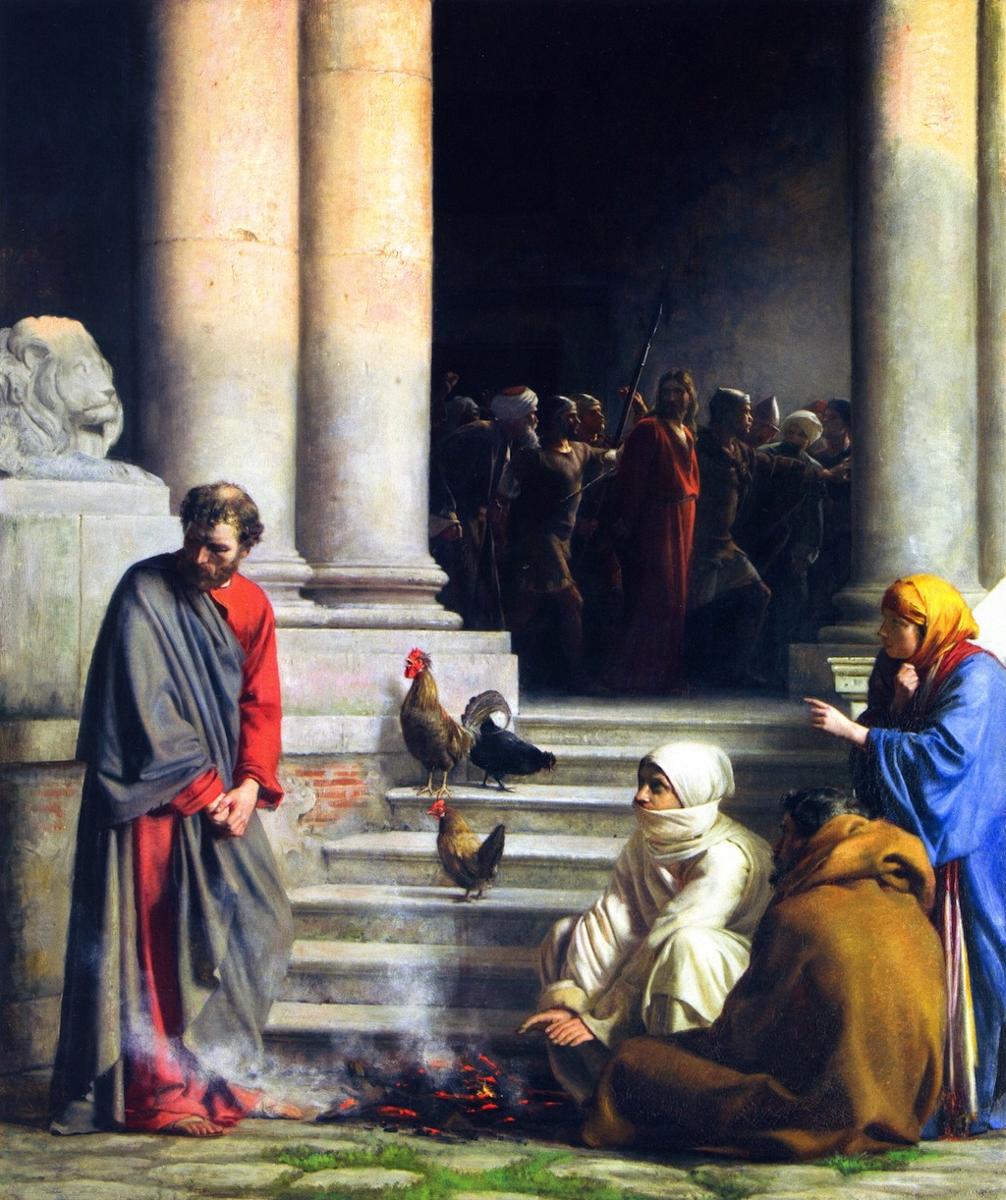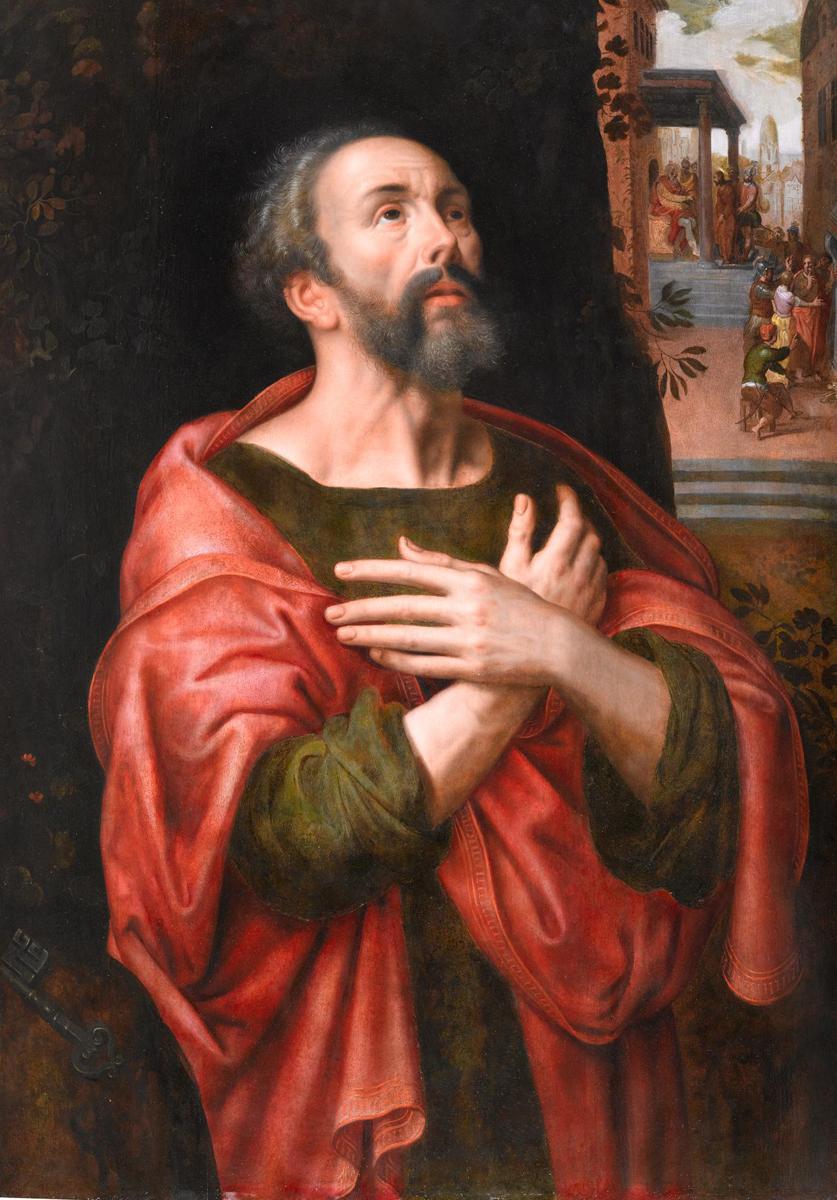February 12: Peter's Remorse
♫ Music:
Friday, February 12
Scripture: Matthew 26
Now Peter was sitting outside in the courtyard. And a servant girl came up to him and said, “You also were with Jesus the Galilean.” But he denied it before them all, saying, “I do not know what you mean.” And when he went out to the entrance, another servant girl saw him, and she said to the bystanders, “This man was with Jesus of Nazareth.” And again he denied it with an oath: “I do not know the man.” After a little while the bystanders came up and said to Peter, “Certainly you too are one of them, for your accent betrays you.” Then he began to invoke a curse on himself and to swear, “I do not know the man.” And immediately the rooster crowed. And Peter remembered the saying of Jesus, “Before the rooster crows, you will deny me three times.” And he went out and wept bitterly.
PETER’S REMORSE
There’s a non-verbal language we all learn early on. It’s in the eyes. Psychologists, criminologists, journalists and education theorists agree that when two people make eye contact, there are complex things that happen, things that are irrefutable. A life can be changed in an instant, in a look.
Matthew 26 makes no reference to eye contact. But this moment in Christ’s journey of suffering is recounted in all four gospels. And in Luke 22:61, Peter — upon hearing a rooster crow — looks up to see Jesus’ gaze on him. It’s that look, along with the piercing, echoing cry of a bird that triggers Peter’s memory.
This is Peter the impulsive one — the disciple who, it would seem, speaks first and thinks later. Peter had told Jesus, in this same chapter, “Even if I must die with you, I will not deny you” (v. 35). Earlier, he had said — in response to Jesus’ prediction that all of His disciples would forsake Him, “even though all fall away because of You, I will never fall away” (v. 33).
But at that moment, in that very public place, Peter bursts into tears. In three separate encounters, he had just denied that Jesus meant anything to him. He had lied. But there was no lie in this remorse. Luke says he leaves the area (Luke 22:62).
The Remorse of St. Peter by Carl Bloch shows Peter averting his eyes with Jesus standing in the background. The stares of the women pierce Peter like lasers. He is bending under them, and under the weight of the moment.
But the image of Jesus in this painting does not show us much of Jesus’ face. His form is nearly a silhouette. Why would Jesus look at Peter? He knew this verbal disciple would lapse. This was yet another teachable moment. The gospels, in varying ways, show Christ’s sovereignty over all of life. Jesus was Lord over even this moment, and just as He had stopped in the garden for teaching about swords and angelic armies (Matt. 26:52-53), now Jesus is pausing in the midst of the charade his trial had become. He looks at Peter, but one can imagine His look is one of tender compassion. He is telling Peter to be strong — that he is not alone, that all will be well, just as He promised.
Jesus had told Peter, as the fisherman’s mind cleared from dozing in the garden, “the spirit is willing, but the flesh is weak” (Matt. 26:41). And Luke, recounting a poignant exchange, has Jesus telling Peter that Satan had targeted him for particular attack (Luke 22:31). But Jesus adds that Satan would not have the last word. In one of the few passages speaking of Jesus’ prayer life, He says “I have prayed for you that your faith may not fail” (Luke 22:32).
So as repentant Peter goes out, perhaps the rest of that conversation comes to him. Jesus had said, “once you have turned, strengthen your brothers” (Luke 22:32). It was as a result of this painful denial that Peter’s pride was destroyed and he became the leader Christ envisioned him to be.
PRAYER
Master, my strength fails, I feel only weakness, irritation and depression. I am tempted to complain and to despair. What has become of the courage I was so proud of, and that gave me so much self-confidence? In addition to my pain, I have to bear the shame of my fretful feebleness. Lord, destroy my pride; leave it no resource. How happy I shall be if you can teach me by these terrible trials, that I am nothing, that I can do nothing, and that you are all! Amen.
- Francois Fénelon, 1651-1715
Michael A. Longinow, Professor of Journalism & Integrated Media
Artwork #1
The Remorse of St. Peter
Carl Bloch
Oil on copper
The Museum of National History at Frederiksborg Castle, Denmark
About the Artist and Art #1
Born in Copenhagen, Denmark, Carl Heinrich Bloch (1834-1890) was a painter who studied at the Royal Danish Academy of Art. He traveled to Italy by way of the Netherlands, where he was strongly influenced by the work of Rembrandt. His early work featured rural scenes from everyday life, which eventually transitioned to lofty altarpiece paintings of the life of Christ. Between 1865 and 1879, Bloch was commissioned to paint 23 paintings for the Chapel at Frederiksborg Palace, one of which was The Remorse of St. Peter.
Artwork #2
St. Peter Penitent
Adriaen Thomasz
Oil on panel
Spinx Fine Art, London, England
About the Artist and Art #2
Adriaen Thomasz (c. 1544-1599) was a Flemish Renaissance portrait painter. He was trained by Willem Key and became a master in the Antwerp Guild of St. Luke in 1568. Adriaen was considered one of the great Antwerp portraitists, although he also painted religious scenes, as exemplified in this work. The figure of St. Peter dominates the composition, framed by two vignettes of the Passion in the background: Christ before Pilate, and the denial of St. Peter. Details such as the dirt under the fingernail of St. Peter’s left thumb, and the teardrops on his cheek depict the very human side of the apostle.
About the Music
“I Cannot Watch Them”
Lyrics
Narration:
And Peter remembered the words of Jesus.
And he went out, and wept bitterly.
Peter:
What have I done? Denied Him? What have I done?
So now am I no different from the men
Who take Thy bread then turn again?
Oh, what have I done? What have I done?
I hear their filthy tongues, their vicious scorn.
The lies they spin with Satan’s yarn.
I watch them spit and strike Thy face,
They mock Thy name in foul disgrace.
And when Thou lookest for a friend,
Thou findest none, for I have fled!
Oh God! What have I done?
As Thou hast taken stripes for me,
Could I not take but one for Thee?
I cannot watch them take my Lord.
I can’t endure their cruel hand upon Him.
While His own hands are tied with cord.
Those hands with pow’r to raise the dead,
Command the storm, now bound instead,
and I cannot hear them mock His name.
I cannot bear their foul breath upon Him.
I dare not look upon His face
And see the very Son of God,
His brow so bruised and stained with blood
His eyes that shed my sorrow’s tears,
And watch as all hope disappears,
I will not watch them crucify my Lord!
For I know this Man! I know Him! I know this Man!
I cannot watch what He must bear.
For surely He must carry all my burden.
Forgive me, Lord, that I’m not there.
But, when my eyes have closed in death,
These words will hang on my last breath: I know Him.
About the Composer
Rob Gardner (b. 1978) is a contemporary composer. He has been playing instruments and singing since he was a child. He writes both sacred and secular music, including film scores and musicals. Gardner is the president of Spire Music, a nonprofit organization whose mission is “to encourage the composition of new works by creating opportunities for their performance.” This work comes from a larger project “Lamb of God,” focusing on the atonement and last days of Jesus Christ as experienced by those closest to Him.
About the Performers
The London Symphony Orchestra is one of the world's most recorded orchestras; it has made gramophone recordings since 1912 and has played on more than 200 soundtrack recordings for the cinema. This track from the “Lamb of God” recording brought together the LSO and the Spire Chorus, comprised of 60 talented singers. Soloist Jordan Bluth is featured in the role of Peter.

